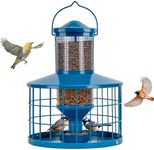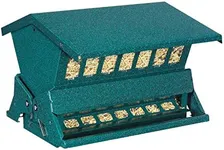Buying Guide for the Best Squirrel Proof Bird Feeders
Choosing a squirrel-proof bird feeder can make birdwatching much more enjoyable by ensuring that your feathered visitors get the food you put out, rather than the local squirrels. The right feeder will depend on your yard, the types of birds you want to attract, and how persistent the squirrels in your area are. Understanding the key features will help you pick a feeder that keeps squirrels at bay while still being inviting and safe for birds.Squirrel-Proof MechanismThe squirrel-proof mechanism is the main feature that prevents squirrels from accessing the bird food. This can include weight-activated perches, cages, or spinning mechanisms. Weight-activated perches close access to the food when a heavier animal (like a squirrel) lands on them, while cages physically block larger animals. Spinning mechanisms gently spin to dislodge squirrels. If you have very determined squirrels, a feeder with a more complex or multi-layered mechanism may be best. For areas with fewer squirrels, a simple cage might suffice. Consider how clever and persistent the local squirrels are when choosing the right mechanism for your needs.
Feeder CapacityFeeder capacity refers to how much bird seed the feeder can hold at one time. Smaller feeders need to be refilled more often but can be easier to clean and maintain, while larger feeders require less frequent refilling but may be heavier and harder to handle. If you have many birds visiting or want to minimize refilling, a larger capacity is helpful. For occasional use or fewer birds, a smaller feeder may be more practical. Think about how often you want to refill the feeder and how many birds you expect to visit.
Material and DurabilityThe material and durability of the feeder are important because squirrels can be quite destructive. Common materials include metal, plastic, and sometimes wood. Metal feeders are generally the most durable and resistant to chewing, while plastic feeders can be lighter but may be damaged by persistent squirrels. If you have aggressive squirrels, opt for a feeder made mostly of metal. For less challenging environments, a sturdy plastic feeder may be sufficient. Consider the weather in your area as well, since some materials withstand the elements better than others.
Ease of CleaningEase of cleaning is about how simple it is to take apart and wash the feeder. Clean feeders help prevent the spread of disease among birds. Some feeders have removable parts or wide openings that make cleaning easier, while others may be more difficult to disassemble. If you want to keep maintenance simple, look for feeders that are designed for easy cleaning. If you don’t mind a bit more effort, you might prioritize other features instead.
Mounting OptionsMounting options refer to how and where you can place the feeder, such as hanging, pole-mounted, or window-mounted. Some feeders are designed to hang from branches or hooks, while others can be attached to poles or even windows. Hanging feeders can be more challenging for squirrels to reach if placed correctly, while pole-mounted feeders may need additional squirrel baffles. Consider where you want to place your feeder and how accessible it will be to both birds and squirrels when choosing the mounting style.
















